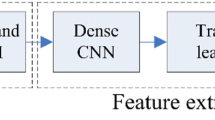Abstract
In this paper, we propose a waveform classification approach for cognitive electronic warfare applications in which a supervised classification method is presented in an efficient framework. In this manner, we introduce an end-to-end framework for detection and classification of radar pulses. Our approach is complete, i.e., we provide raw radar signal at the input side and produce categorical output in the end. We use short-time Fourier transform to obtain time–frequency image (TFI) of the signal. Hough transform is used to detect pulses in TFIs. Convolutional neural networks (CNN) are used for intra-pulse modulation classification. In experiments, we provide supervised classification results at different signal-to-noise ratio (SNR) levels and achieve 98.08% classification accuracy for 10 dB SNR on a diverse set of both frequency- and phase-modulated signals. The method sustains high classification accuracy levels as [93.9%;85.83%] for 0 and \(-10\) dB SNR, respectively, that signifies the robustness of the method against noise for low-power intercepted signals. Simulation results also show that CNN outperforms artificial neural networks in intra-pulse modulation classification task.







Similar content being viewed by others
References
Adamy, D.: EW 101: A First Course in Electronic Warfare. Artech House radar library. Artech House (2001). https://books.google.com.tr/books?id=ta3hngEACAAJ
Adamy, D.: EW 102: A second course in electronic warfare. Artech house radar library. Artech house (2004). https://books.google.com.tr/books?id=-AkfVZskc64C
Ayazgok, S., Erdem, C., Ozturk, M.T., Orduyilmaz, A., Serin, M.: Automatic antenna scan type classification for next-generation electronic warfare receivers. IET Radar Sonar Navig. 12(4), 466–474 (2018). https://doi.org/10.1049/iet-rsn.2017.0354
Chao Wang, Gao, H., Xudong Zhang: Radar signal classification based on auto-correlation function and directed graphical model. In: 2016 IEEE International Conference on Signal Processing, Communications and Computing (ICSPCC), pp. 1–4 (2016)
He, K., Gkioxari, G., Dollár, P., Girshick, R.B.: Mask R-CNN. CoRR (2017). abs/1703.06870http://arxiv.org/abs/1703.06870
Hsiung, W.C.: A prototype rule based system for electronic warfare (1991)
Ioffe, S., Szegedy, C.: Batch normalization: accelerating deep network training by reducing internal covariate shift. In: Proceedings of the 32Nd International Conference on International Conference on Machine Learning - Volume 37, ICML’15, pp. 448–456. JMLR.org (2015). http://dl.acm.org/citation.cfm?id=3045118.3045167
Karpathy, A., Toderici, G., Shetty, S., Leung, T., Sukthankar, R., Fei-Fei, L.: Large-scale video classification with convolutional neural networks. In: 2014 IEEE Conference on Computer Vision and Pattern Recognition, pp. 1725–1732 (2014). https://doi.org/10.1109/CVPR.2014.223
Kawalec, A., Owczarek, R.: Radar emitter recognition using intrapulse data. In: 15th International Conference on Microwaves, Radar and Wireless Communications (IEEE Cat. No.04EX824), vol. 2, pp. 435–438 Vol.2 (2004). https://doi.org/10.1109/MIKON.2004.1357059
Kong, S., Kim, M., Hoang, L.M., Kim, E.: Automatic lpi radar waveform recognition using cnn. IEEE Access 6, 4207–4219 (2018). https://doi.org/10.1109/ACCESS.2017.2788942
Krizhevsky, A., Sutskever, I., Hinton, G.E.: Imagenet classification with deep convolutional neural networks. In: Proceedings of the 25th International Conference on Neural Information Processing Systems - Volume 1, NIPS’12, pp. 1097–1105. Curran Associates Inc., USA (2012). http://dl.acm.org/citation.cfm?id=2999134.2999257
Lecun, Y., Bottou, L., Bengio, Y., Haffner, P.: Gradient-based learning applied to document recognition. Proc. IEEE 86(11), 2278–2324 (1998). https://doi.org/10.1109/5.726791
Levanon, N., Mozeson, E.: Radar Signals (2004). https://doi.org/10.1002/0471663085
Lunden, J., Koivunen, V.: Automatic radar waveform recognition. IEEE J. Sel. Topics Signal Process. 1(1), 124–136 (2007). https://doi.org/10.1109/JSTSP.2007.897055
Mingqiu, R., Jinyan, C., Yuanqing, Z.: Classification of radar signals using time-frequency transforms and fuzzy clustering (2010). https://doi.org/10.1109/ICMMT.2010.5525213
Mingqiu Ren, Jinyan Cai, Yuanqing Zhu, Minghao He: Radar emitter signal classification based on mutual information and fuzzy support vector machines. In: 2008 9th International Conference on Signal Processing, pp. 1641–1646 (2008). https://doi.org/10.1109/ICOSP.2008.4697451
Nair, V., Hinton, G.E.: Rectified linear units improve restricted boltzmann machines. In: Proceedings of the 27th International Conference on International Conference on Machine Learning, ICML’10, pp. 807–814. Omnipress, USA (2010). http://dl.acm.org/citation.cfm?id=3104322.3104425
Pace, P.: Detecting and Classifying Low Probability of Intercept Radar. Artech House radar library. Artech House (2009). https://books.google.com.tr/books?id=K_T4M-nA6JYC
Paszke, A., Gross, S., Massa, F., Lerer, A., Bradbury, J., Chanan, G., Killeen, T., Lin, Z., Gimelshein, N., Antiga, L., Desmaison, A., Kopf, A., Yang, E., DeVito, Z., Raison, M., Tejani, A., Chilamkurthy, S., Steiner, B., Fang, L., Bai, J., Chintala, S.: Pytorch: An imperative style, high-performance deep learning library. In: H. Wallach, H. Larochelle, A. Beygelzimer, F. d’ Alché-Buc, E. Fox, R. Garnett (eds.) Advances in Neural Information Processing Systems 32, pp. 8024–8035. Curran Associates, Inc. (2019). http://papers.neurips.cc/paper/9015-pytorch-an-imperative-style-high-performance-deep-learning-library.pdf
Skolnik, M.: Radar Handbook, Third Edition. Electronics electrical engineering. McGraw-Hill Education (2008). https://books.google.com.tr/books?id=76uF2Xebm-gC
Wang, C., Wang, J., Zhang, X.: Automatic radar waveform recognition based on time-frequency analysis and convolutional neural network. In: 2017 IEEE International Conference on Acoustics, Speech and Signal Processing (ICASSP), pp. 2437–2441 (2017). https://doi.org/10.1109/ICASSP.2017.7952594
Wiley, R.: ELINT: The Interception and Analysis of Radar Signals. Artech House radar library. Artech House (2006). https://books.google.com.tr/books?id=vQNTAAAAMAAJ
Yar, E., Kocamis, M.B., Orduyilmaz, A., Serin, M., Efe, M.: A complete framework of radar pulse detection and modulation classification for cognitive ew. In: 2019 27th European Signal Processing Conference (EUSIPCO), pp. 1–5 (2019)
Author information
Authors and Affiliations
Corresponding author
Additional information
Publisher's Note
Springer Nature remains neutral with regard to jurisdictional claims in published maps and institutional affiliations.
Rights and permissions
About this article
Cite this article
Orduyilmaz, A., Yar, E., Kocamis, M.B. et al. Machine learning-based radar waveform classification for cognitive EW. SIViP 15, 1653–1662 (2021). https://doi.org/10.1007/s11760-021-01901-w
Received:
Revised:
Accepted:
Published:
Issue Date:
DOI: https://doi.org/10.1007/s11760-021-01901-w




